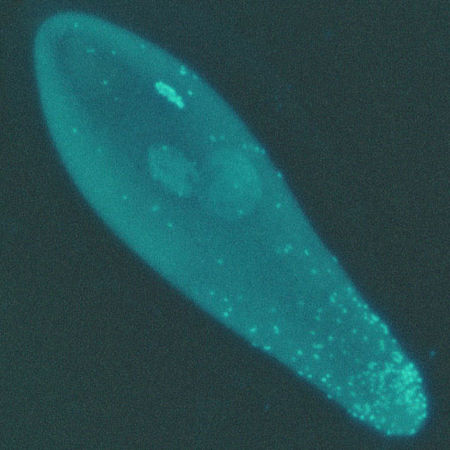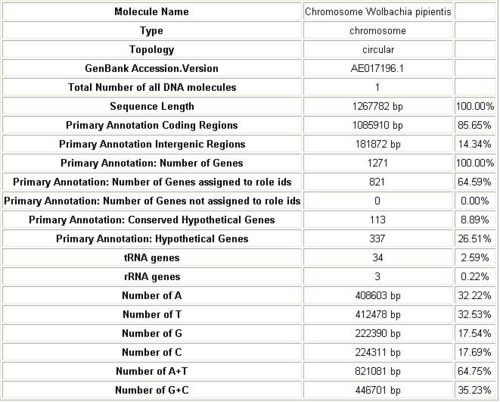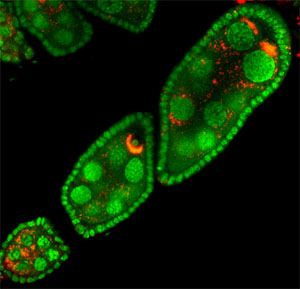Wolbachia pipientis: Difference between revisions
No edit summary |
|||
| (4 intermediate revisions by 2 users not shown) | |||
| Line 2: | Line 2: | ||
{{Biorealm Genus}} | {{Biorealm Genus}} | ||
[[Image:Wolbachia | [[Image:Wolbachia pipientis_Photo.jpg |thumb|450px|right|In a stained egg of the small parasitic wasp, ''Trichogramma kaykai'', are brightly staining ''Wolbachia''. The bacteria accumulate at the end of the egg that is destined to develop into the reproductive organs. Wolbachia induce the eggs of this wasp to develop into female offspring without fertilization. Photo Credit: Merijn Salverda and Richard Stouthamer.]] | ||
==Classification== | ==Classification== | ||
===Higher Order Taxa=== | ===Higher Order Taxa=== | ||
Scientific classification | |||
Bacteria | Domain: Bacteria | ||
Phylum: Proteobacteria | |||
Class: Alphaproteobacteria | |||
Subclass:Rickettsidae | |||
Order: Rickettsiales | |||
Family: Rickettsiaceae | |||
Genus: Wolbachia | |||
Species of Wolbachia | |||
Wolbachia melophagi (Nöller 1917) Philip 1956[1] Wolbachia persica Suitor and Weiss 1961[2] Wolbachia pipientis Hertig 1936 | |||
===Genus and Species=== | ===Genus and Species=== | ||
| Line 22: | Line 30: | ||
==Description and Significance== | ==Description and Significance== | ||
''Wolbachia pipientis'' are bacteria that infect a wide range of invertebrate, mainly arthropods and | ''Wolbachia pipientis'' are bacteria that infect a wide range of invertebrate, mainly arthropods and nematodes. Wolbachia is one of the most common natural pathogens on Earth that alter the reproductive system of insects; it is estimated that more than 18-76% of insects are infected by it including spider, termites, mosquito, flies and nematoades. The bacteria give various physical characteristics of its infection that cause a variety of result including deterring chromosomal sex determination from gamete fertilization. Also, it may initiate parthenogenesis that causes growth and development without fertilization by sperm (parthenogenesis) because it can selectively kill males; thus, it creates a detrimental competition against sperm and causes cytoplasmic incompatibility in fertilized eggs. Wolbachia's uniqueness in altering reproduction has caused many scientists to research the biology of infection and their potential use for controlling pest and pathogens. | ||
==Genome Structure== | ==Genome Structure== | ||
| Line 57: | Line 65: | ||
==Current Research== | ==Current Research== | ||
* | *Wolbachia pipientis is a intracelluler gram negative bacteria, firstly identified in 1924 by Hertig and Wolbach in sex cells of ''Culex pipiens'', a species of mosquito, while comprehensive description were published by Hertig in 1936. Last few decades wolbachia become a noval endosymbiotic natural bio-control agent due to its ubiquitous phenotyptic behavior. Now a days lot of genomic research conduct on this multi-functional bacteria ( Parasitic and Mutualistic behavior).Here some examples of recent published research work related to this bacteria: | ||
*Research | *The Intracellular Bacterium Wolbachia Uses Parasitoid Wasps as Phoretic Vectors for Efficient Horizontal Transmission | ||
* | PLoS Pathog (2015)11(2): e1004672. doi:10.1371/journal.ppat.1004672 | ||
* | *Wolbachia-Based Population Control Strategy Targeting Culex quinquefasciatus Mosquitoes Proves Efficient under Semi-Field Conditions | ||
Research Article | published 13 Mar 2015 | PLOS ONE 10.1371/journal.pone.0119288 | |||
*Wolbachia Infection Dynamics in Tribolium confusum (Coleoptera: Tenebrionidae) and Their Effects on Host Mating Behavior and Reproduction | |||
J. Econ. Entomol. 108(3): 1408–1415 (2015); DOI: 10.1093/jee/tov053 | |||
*Characterization of Wolbachia cell division protein (ftsz) gene for potential management of Uzifly Exorista sorbillans (Diptera: Tachinidae) | |||
Journal of Entomology and Zoology Studies 2015; 3 (2): 57-61 | |||
*Wolbachia infection affects female fecundity in Drosophila suzukii | |||
Bulletin of Insectology 68 (1): 153-157, 2015 ISSN 1721-8861 | |||
*How do hosts react to endosymbionts? A new insight into the molecular mechanisms underlying the Wolbachia–host association | |||
Insect Molecular Biology (2015) 24(1), 1–12 | |||
*Evidence of natural Wolbachia infections in field populations of Anopheles gambiae | |||
Nature Communications 06 Jun 2014 | |||
*Lateral transfers of insertion sequences between Wolbachia, Cardinium and Rickettsia bacterial endosymbionts | |||
Heredity (2013), 1–8: doi:10.1038/hdy.2013.56 | |||
==References== | ==References== | ||
Latest revision as of 13:49, 15 October 2016
A Microbial Biorealm page on the genus Wolbachia pipientis

Classification
Higher Order Taxa
Scientific classification Domain: Bacteria Phylum: Proteobacteria Class: Alphaproteobacteria Subclass:Rickettsidae Order: Rickettsiales Family: Rickettsiaceae Genus: Wolbachia Species of Wolbachia Wolbachia melophagi (Nöller 1917) Philip 1956[1] Wolbachia persica Suitor and Weiss 1961[2] Wolbachia pipientis Hertig 1936
Genus and Species
Wolbachia pipientis
|
NCBI: Taxonomy Genome: - Wolbachia pipientis wMel |
Description and Significance
Wolbachia pipientis are bacteria that infect a wide range of invertebrate, mainly arthropods and nematodes. Wolbachia is one of the most common natural pathogens on Earth that alter the reproductive system of insects; it is estimated that more than 18-76% of insects are infected by it including spider, termites, mosquito, flies and nematoades. The bacteria give various physical characteristics of its infection that cause a variety of result including deterring chromosomal sex determination from gamete fertilization. Also, it may initiate parthenogenesis that causes growth and development without fertilization by sperm (parthenogenesis) because it can selectively kill males; thus, it creates a detrimental competition against sperm and causes cytoplasmic incompatibility in fertilized eggs. Wolbachia's uniqueness in altering reproduction has caused many scientists to research the biology of infection and their potential use for controlling pest and pathogens.
Genome Structure
From further observation of the genomic structure has unfolded the many mysteries of biology and evolution of the bacteria. For instance, orthologous genes that are unique from bacteria of the same genus show a similar pattern among the bacteria that originate from the same ancestor. Different species of the same genus have closely related DNA sequences with the same repetitiveness and mobile elements. According to a research, this observation, in conjunction with evolutionary dogma, gives an impression that natural selection may somehow ineffective because of population bottleneck.
Furthermore, the chromosome of Wolbachia appears to be circular just like many other bacteria with about 1.3mbp. Of the sequence, about 1mbp are the primary coding region. The number of genes are estimated to be around 800 with 34 tRNA genes and 3 rRNA genes. The number of A+T nucleotides base pairing is estimated 65% while the number of G+C nucleotides base pairing is 35%.
Cell Structure and Metabolism
Wolbachia is a gram-negative bacteria. In these bacteria, the cell wall contains fewer layer of peptidoglycan than gram-positive bacteria. So, the structure of the outer membrane contains porins that help to transfer molecules, and lipopolysaccharide that contains Lipid A, core polysaccharide, and O-polysaccharide. Furthermore, lipoproteins are attached to the polysaccharide backbone.
Another analysis to the genomes, shows a pattern of paralogous genes which have similar function, but often times not because the copy of the duplicated gene is less practical; this copy is free to mutate and acquire new functions. Unlike the metabolic activity of a closely related Rickettsia that is able to generate ATP from their hosts, Wolbachia use glycolysis and purine synthesis. Another observation includes the lack of lipopolysaccharide synthesis in Wolbachia.
Ecology
Based on many studies, the evidence of vertical gene transfer in their hosts by Wolbachia is apparent. However, there’s no proof that supports any lateral gene transfer between Wolbachia and D. melanogaster or between Wolbachia and any other hosts. Furthermore, evolutionary evidence shows that mitochondria share a common ancestor with alpha-Proteobacteria, but has no evidence for similarity with mitochondria with species in the order of Rickettsiales.
Pathology
Wolbachia is a parasitic bacteria that infects reproductive system of insects which ultimately affects their linage continuation. The symbiosis between the bacteria and host is complex. Depending on the interaction, it ranges from mutualism to parasitism. The bacteria infect different types of organ, but the remarkable characteristic is their ability to alter the way maternal genes are passed on to the next generation by infecting the testes and ovaries of their hosts. There are four different phenotypes expressed:
- male killing (death of infected males). This selectively allows females to survive and more likely to reproduce even in the absence of males.
- feminization (infected males grow as either fully fertile females or infertile pseudo-females)
- parthenogenesis(reproduction of infected females asexually)
- Cytoplasmic incompatibility (the inability of Wolbachia-infected males to successfully reproduce with uninfected females). This method causes a certain Wolbachia strain to be more dominant over the others.
Furthermore, Wolbachia are not found in mature sperms, but are found in mature eggs. So, the infection is carried along to offspring by infected females but not males.
Application to Biotechnology
Currently, there's no known compound or enzyme identified for biotechnological use.
Current Research
- Wolbachia pipientis is a intracelluler gram negative bacteria, firstly identified in 1924 by Hertig and Wolbach in sex cells of Culex pipiens, a species of mosquito, while comprehensive description were published by Hertig in 1936. Last few decades wolbachia become a noval endosymbiotic natural bio-control agent due to its ubiquitous phenotyptic behavior. Now a days lot of genomic research conduct on this multi-functional bacteria ( Parasitic and Mutualistic behavior).Here some examples of recent published research work related to this bacteria:
- The Intracellular Bacterium Wolbachia Uses Parasitoid Wasps as Phoretic Vectors for Efficient Horizontal Transmission
PLoS Pathog (2015)11(2): e1004672. doi:10.1371/journal.ppat.1004672
- Wolbachia-Based Population Control Strategy Targeting Culex quinquefasciatus Mosquitoes Proves Efficient under Semi-Field Conditions
Research Article | published 13 Mar 2015 | PLOS ONE 10.1371/journal.pone.0119288
- Wolbachia Infection Dynamics in Tribolium confusum (Coleoptera: Tenebrionidae) and Their Effects on Host Mating Behavior and Reproduction
J. Econ. Entomol. 108(3): 1408–1415 (2015); DOI: 10.1093/jee/tov053
- Characterization of Wolbachia cell division protein (ftsz) gene for potential management of Uzifly Exorista sorbillans (Diptera: Tachinidae)
Journal of Entomology and Zoology Studies 2015; 3 (2): 57-61
- Wolbachia infection affects female fecundity in Drosophila suzukii
Bulletin of Insectology 68 (1): 153-157, 2015 ISSN 1721-8861
- How do hosts react to endosymbionts? A new insight into the molecular mechanisms underlying the Wolbachia–host association
Insect Molecular Biology (2015) 24(1), 1–12
- Evidence of natural Wolbachia infections in field populations of Anopheles gambiae
Nature Communications 06 Jun 2014
- Lateral transfers of insertion sequences between Wolbachia, Cardinium and Rickettsia bacterial endosymbionts
Heredity (2013), 1–8: doi:10.1038/hdy.2013.56
References
Description and Significance:
Genome Structure
Pathology
Current Research
- M. Hertig & S. B. Wolbach (1924). "Studies on Rickettsia-like microorganisms in insects". Journal of Medical Research 44: 329–374
- Research by Sullivan
- Interaction of Drosophila and its endosymbiont Wolbachia
- Using Wolbachia to reduce virus transmission


